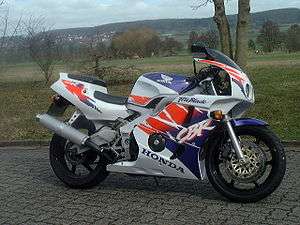Honda CBR400
 | |
| Manufacturer | Honda |
|---|---|
| Production |
1983–1994 2013–present (CBR400R) |
| Class | Sport bike |
The Honda CBR400 is a Japanese domestic market small-capacity sport motorcycle, part of the CBR series introduced by Honda in 1983. It is the first Honda motorcycle to wear a CBR badge.
First incarnation of the CBR400 came about in 1983 as the CBR400F NC17 as a naked bike. The CBR400F was launched in December 1983. The 4-valves per cylinder, air-cooled, four-stroke, DOHC, inline-four engine had a rotational-speed valve stop mechanism "REV" (a prototype of Honda's VTEC system) that changed from two valves into four valves at 9,500 rpm. The following two years, it came as semi- and fully faired version as the F3 Endurance. The CBR400R and early CBR400RR models both carry the model number NC23, which makes up the first part of these bikes' frame numbers. The early NC23 was designated CBR400R and is also known as Aero, Hurricane or Jellymould, as it shares its major design features with the rest of the early CBR family of motorcycles, which included significantly rounded body shapes, whereas the later NC23 is designated CBR400RR and is also known as the Tri-Arm, after its racing inspired braced swingarm.

However, the CBR400RR is considered the most closely related of Honda's 400 cc models to the CBR900RR or Fireblade series of large-capacity sport motorcycles. The CBR400RR preceded the 900 cc (55 cu in) Fireblade by four model years, going through one major rework (signified by a new "gull-arm" swing arm design and a new model number, NC29), and several years of production in its new form before acquiring the FireBlade name for the 1994 model year.
The CBR400RR models, therefore, consist of the later NC23 CBR400RR-J (1988) and CBR400RR-K (1989) models as well as the NC29 CBR400RR-L (1990 & 1991), -N (1992 & 1993) and -R (1994 onwards).[1] The name "Tri-Arm" is shown on the CBR400RR-J's bodywork, along with Hurricane, but the CBR400RR-K dropped the latter designation.[2]

The NC23 CBR400RR features a standard extruded beam frame, the rear of the seat unit slopes forwards, and the seat unit subframe is totally separate from the main chassis of the bike. The NC29 (only the -R models of which carry the FireBlade name) had several modifications to the frame. The main rails were of a 'cranked' design, the seat support structure had a larger rail that was welded to the frame, the rear of the tail section now had a slight recurve to it, and the swingarm was given a gull-wing shape on one side to give ground clearance for the exhaust link pipe. The bodywork was reshaped to comply with changing aesthetic tastes.
Developed mostly for younger Japanese riders, the 400 cc (24 cu in) engine still had enough power to drive the bike up to a speed-limited 180 km/h (110 mph). The inline-four engine produces pleasing power anywhere in its rev range, and the bike is light and relatively easy to control. Outside the Japan, the CBR400RR was available only as a grey market import. The small capacity of the engine and manageability of the whole package makes this bike a favourite of new riders from all areas where the bike is available.
The DOHC cam gear train engine from the NC23 was later used in the NC29 and the CB400F CB-1, model number NC27, a naked bike that is credited with inspiring the popular 'Hornet' range. However the NC27 bears little mechanical resemblance to those machines and is probably the first true factory streetfighter.
In 2013, Honda released the new twin-cylinder CBR400R along with its naked model, the CB400F (not to be confused with four-cylinder CB400 Super Four), and sport adventure model, the CB400X, which is based on the CBR500R, CB500F, and CB500X respectively. These models are sold in Japan only.[3]
References
- ↑ Coombs, M: "Honda CBR400RR Service and Repair Manual, p. 8, Haynes Publishing, 2005
- ↑ Honda CBR400R and CBR400RR model brochures, Honda Motor Co., Japan [various years]
- ↑ "Honda CBR400R Resmi Diaspalkan". Otosia. 2013-06-01. Retrieved 2016-07-29.
External links
| « previous - Honda motorcycle timeline, 1980s (street) - next » | |||||||||||||||||||||
|---|---|---|---|---|---|---|---|---|---|---|---|---|---|---|---|---|---|---|---|---|---|
| Type | 1980s | ||||||||||||||||||||
| 0 | 1 | 2 | 3 | 4 | 5 | 6 | 7 | 8 | 9 | ||||||||||||
| Standard | CG125 | ||||||||||||||||||||
| CD125 Benly | |||||||||||||||||||||
| CB250N | CB250 Nighthawk | ||||||||||||||||||||
| VT250-FII | VTR250 Interceptor | VT250 Spada | |||||||||||||||||||
| CB-1 | |||||||||||||||||||||
| CB400N Super Dream | |||||||||||||||||||||
| CB400T | CB450SC/Nighthawk | ||||||||||||||||||||
| CX500/GL500 | CX650/GL650 | ||||||||||||||||||||
| XBR500 | GB500 | ||||||||||||||||||||
| CB550SC/Nighthawk | |||||||||||||||||||||
| CB650 / CB650C | CB650SC/Nighthawk | ||||||||||||||||||||
| CB700SC/Nighthawk | |||||||||||||||||||||
| CB750SC/Nighthawk | |||||||||||||||||||||
| CB750 C,F,K,SC | |||||||||||||||||||||
| CB900F | |||||||||||||||||||||
| CB1100F | Sabre | ||||||||||||||||||||
| Sport | NSR125 | ||||||||||||||||||||
| CBR250 | |||||||||||||||||||||
| CBR600F | |||||||||||||||||||||
| Sport touring | VF500F | ||||||||||||||||||||
| CBX550F | |||||||||||||||||||||
| VF750F | VFR750F | ||||||||||||||||||||
| VF1000F | |||||||||||||||||||||
| CBX | |||||||||||||||||||||
| CBR1000F | |||||||||||||||||||||
| Touring | PC800 | ||||||||||||||||||||
| GL1100 Gold Wing | GL1200 Gold Wing | GL1500 Gold Wing | |||||||||||||||||||
| Cruiser | CM200 Twinstar | ||||||||||||||||||||
| CMX250/Rebel | |||||||||||||||||||||
| CM400 | CM450 | CMX450/Rebel | |||||||||||||||||||
| Shadow | |||||||||||||||||||||
| Magna | |||||||||||||||||||||
| CB900C | CB1000C | ||||||||||||||||||||
| Dual-Sport | NX250 | ||||||||||||||||||||
| NX650 | |||||||||||||||||||||
| « previous - Honda motorcycle timeline, 1990s (street) - next » | ||||||||||||||||||||||
|---|---|---|---|---|---|---|---|---|---|---|---|---|---|---|---|---|---|---|---|---|---|---|
| Type | 1990s | |||||||||||||||||||||
| 0 | 1 | 2 | 3 | 4 | 5 | 6 | 7 | 8 | 9 | |||||||||||||
| Standard | CG125 | |||||||||||||||||||||
| VTR250 (US) | VTR250 (Asia-Pacific) | |||||||||||||||||||||
| GB500 | CB500 twin | |||||||||||||||||||||
| CB250 Nighthawk | ||||||||||||||||||||||
| CB750 Nighthawk | ||||||||||||||||||||||
| CB-1/CB400F | CB400SF | |||||||||||||||||||||
| NT650 Hawk | CB600F Hornet, 599 | |||||||||||||||||||||
| Sport | NSR125 | |||||||||||||||||||||
| CBR250 | ||||||||||||||||||||||
| CBR600F | CBR600F2 | CBR600F3 | CBR600F4 | |||||||||||||||||||
| CBR900RR Fireblade | ||||||||||||||||||||||
| VTR1000F Superhawk | ||||||||||||||||||||||
| CBR1000F Hurricane | CBR1100XX Super Blackbird | |||||||||||||||||||||
| Touring | VFR750F | VFR800 Interceptor | ||||||||||||||||||||
| PC800 Pacific Coast | ||||||||||||||||||||||
| NT650V Deauville | ||||||||||||||||||||||
| ST1100/Pan-European | ||||||||||||||||||||||
| GL1500 Gold Wing | ||||||||||||||||||||||
| Cruiser | VT1100C | VT1100C Shadow | ||||||||||||||||||||
| VT600C Shadow | ||||||||||||||||||||||
| VT750C Shadow | ||||||||||||||||||||||
| CMX250C Rebel | CMX250C | |||||||||||||||||||||
| VF750C Magna | ||||||||||||||||||||||
| GL1500C Valkyrie | ||||||||||||||||||||||
| Dual-sport | NX125 Transcity (US sales ended 1990) | |||||||||||||||||||||
| NX250 | ||||||||||||||||||||||
| NX650 Dominator | ||||||||||||||||||||||
| XL600V/XL650V/XL700V Transalp | ||||||||||||||||||||||
| XRV650/XRV750/Africa Twin | ||||||||||||||||||||||
| XL1000V Varadero | ||||||||||||||||||||||
| Wikimedia Commons has media related to Honda CBR400. |